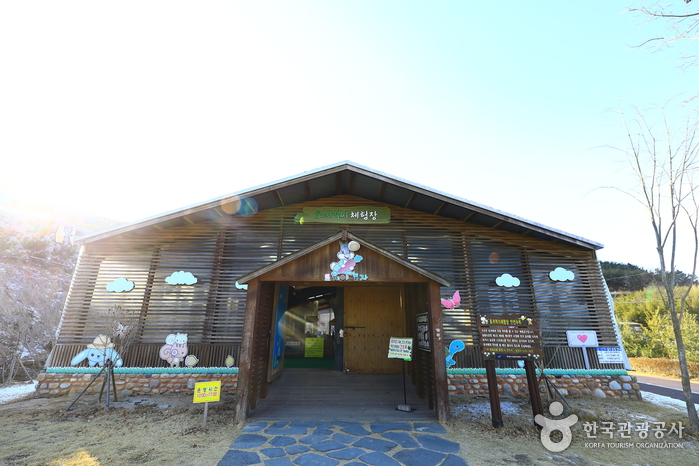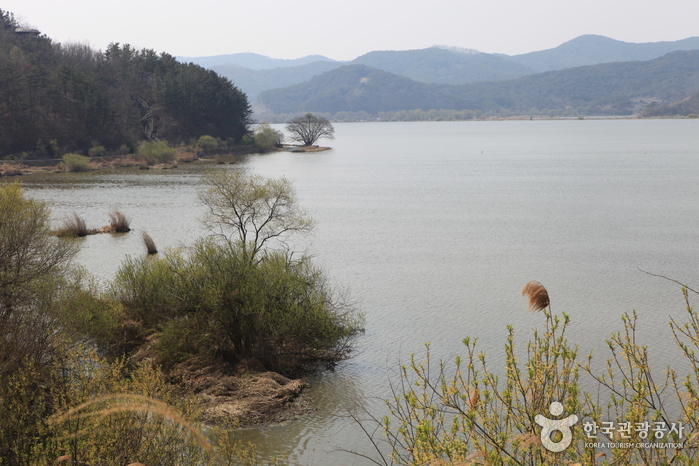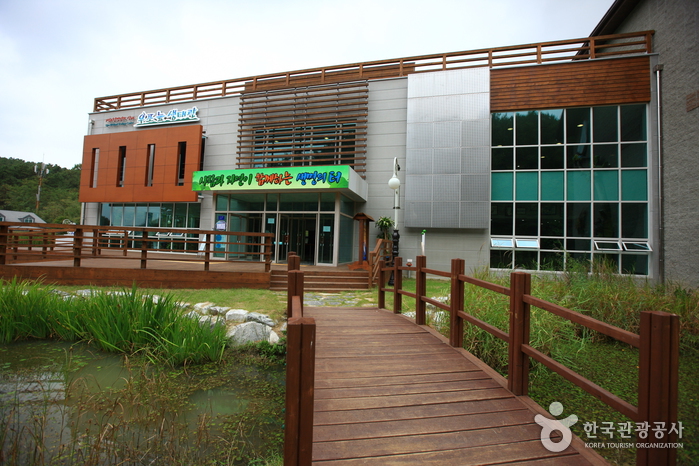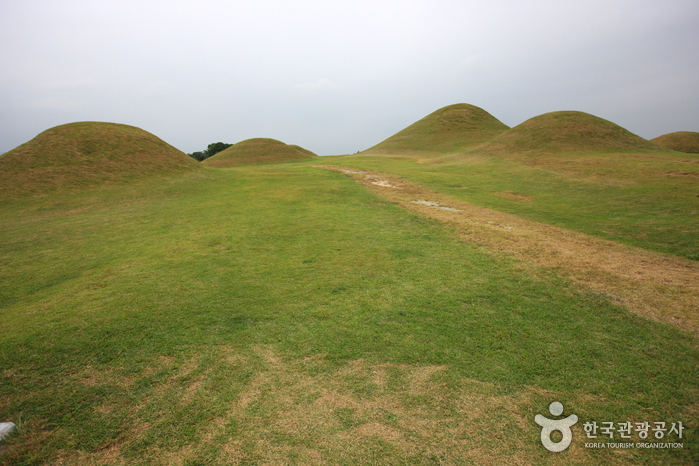Santokki Park (산토끼 노래동산)
.0M 2023-06-27
623 , Ibang-ro, Changnyeong-gun, Gyeongsangnam-do
+82-0507-1352-1401
Santokki Park is a recreational space located behind Ibang Elementary School in Changnyeong-gun. The park was inspired by the children's song "Santokki," meaning mountain rabbit, composed and written by Lee Il-lae who was a staff at Ibang Elementary School. The park comprises a variety of things to do and see related to rabbits, including a rabbit village, rabbit cave, and rabbit feeding experience. There are also spaces dedicated to Lee Il-lae, his work, and small animals. The park is kids-friendly with recreational places where children can freely run around as well as other amenities that help visitors rest and relax.
Changnyeong Upo Wetland (창녕 우포늪)
3.6Km 2023-02-13
220, Uponeup-gil, Changnyeong-gun, Gyeongsangnam-do
+82-55-530-1533
Upo Wetland is the largest natural wetland in Korea. The wetland takes up three different areas of Changnyeong-gun with a total size of 2,314,060 square meters. Created approximately 140 million years ago, the wetland was formed when the soft ground collapsed and water filled the area to form swamps and lakes, where dinosaurs played. Dinosaur footprints can be found at Sejin-ri near Upo Wetland.
Upo Wetland Eco Center (우포늪생태관)
4.5Km 2021-08-23
220, Uponeup-gil, Changnyeong-gun, Gyeongsangnam-do
+82-2-1330
Upo Wetland Eco Center is a wetland education center at the largest wetland in Korea. The center collects data and conducts research on various wild wetland animals such as birds, fish, mammals, amphibians, and reptiles, and displays these to the public as well as promotes the message that humans are also part of nature and educates visitors on how humans can live in harmony with nature.
To help visitors learn more about the ecological environment, the center consists of various galleries: Understanding Upo Wetland, the Four Seasons of Upo Wetland, Living Upo Wetland, Families of Upo Wetland, and Understanding the Ecological Environment. Each gallery exhibits dynamic models and videos, as well as hands-on interactive programs.
Twelve Tablet Pavilion of Hyeonpung Gwak Clan (현풍곽씨십이정려각)
10.7Km 2020-04-14
3, Jidong-gil, Dalseong-gun, Daegu
+82-53-668-3162
Designated as Daegu’s Cultural Property No. 29 on May 12, 1995, Twelve Tablet Pavilion of Hyeonpung Gwak Clan (Jongnyeo-gak of the Hyeonpung Lineage of the Kwak Clan) was built in the mid-Joseon period during King Yeongjo's rule. The pavilion houses 12 Jeongnyeo-gak tablets awarded to the members of the Gwak Clan from the time of King Seonjo in 1598 to the time of King Yeongjo.
It is an important and unique hertiage because the Gwak Clan attained their 12 Jeongnyeo-gak tablats all in one village, which is quite uncommon. During the Joseon dynasty, Jeongnyeo-gak tablets were awarded to honor loyal retainers, devoted sons, and exemplary husbands and wives.
Ancient Tombs in Gyo-dong and Songhyeon-dong, Changnyeong (창녕 교동과 송현동 고분군)
11.1Km 2023-06-27
34, Changmil-ro, Changnyeong-gun, Gyeongsangnam-do
+82-55-530-1471
Songhyeon-dong Ancient Tombs, located under Mokmasanseong Fortress at the west foot of Hwawangsan Mountain, are large ancient tombs located in the southwest by the road leading to Hyeonpung. The Gyo-dong Ancient Tombs are dozens of ancient tombs that were once gathered around a large royal tomb, which among only eight tombs with damaged mounds now remain. Some of these ancient tombs were excavated by the Japanese between 1918 and 1919, and most of the relics were moved to Japan, and only some of them remain in Korea. According to the results of the investigation at the time, the large tombs were either built in a passageway form or an entry gate form.
It is said that a large number of relics such as jewelry made of various precious metals, including gold crowns, pure gold transplants, and copper, iron armour, and earthenware were excavated. The excavation report left by the Japanese is simple, so it is not possible to accurately grasp the structure of the Gyo-dong Ancient Tombs and the excavated relics. Twenty-one of the existing tombs have been restored so far, and only one of them has an accessible entrance.
The tombs in Songhyeon-dong are largely divided into two areas. Area 1 used to be large tombs with 80 tombs west of the foot of Mokmasan Mountain, but now only about 16 tombs remain. It is said that there were about 20 tombs in the second area near the stone Buddha in Songhyeon-dong, but now most of them have turned into rice paddies, and only a few tombs reveal their original appearance. Since the tombs are close to the Gyo-dong tombs, the structure of the tomb and the nature of the relics are believed to be almost the same. Along with the Gyo-dong tombs, a large number of relics were excavated in 1918, but the whereabouts of some of the relics are unknown.
161 Coffee Studio (161스튜디오)
13.7Km 2024-02-15
581, Biseul-ro, Hyeonpung-eup, Dalseong-gun, Daegu
161 Coffee Studio is a spacious bakery café, complete with a terrace and an outdoor grassy yard. It's particularly popular for being kid-friendly, offering various facilities and games for children. In the fall, the café becomes especially picturesque as the yard is adorned with lush pink muhly grass, earning it the nickname "the pink muhly café." The café's menu includes a range of drinks and desserts, with the Salt Coffee (salt cream einspänner) standing out as its signature beverage. Inside, the café's large picture windows provide a panoramic view of the surrounding fields, adding to the overall ambiance.
Dodongseowon Confucian Academy [UNESCO World Heritage] (도동서원 [유네스코 세계문화유산])
13.9Km 2023-01-05
726, Gujiseo-ro, Dalseong-gun, Daegu
+82-53-616-6407
Dodongseowon Confucian Academy was first established by Confucian scholars in 1568 at the eastern base of Biseulsan Mountain, but was burnt down during the Imjin War (1592-1598). In 1605, the school was reconstructed on its current site and was renamed Borodongseowon. In 1607, the name was changed to Dongdoseowon. "Dongdo" means that the teachings ("do") of Confucianism come from the East (dong in Korean). Dodongseowon is one of the 47 major Confucian academies that was not affected by Heungseon Daewongun's order to eliminate Confucian academies.
Daegu National Science Museum (국립대구과학관)
14.1Km 2023-01-05
20, Techno-daero 6-gil, Dalseong-gun, Daegu
+82-53-670-6114
At Daegu National Science Museum, children can explore the world of science while they play and participate in diverse hands-on activities. Various science programs provide opportunities for children to use their imagination and creativity as they engage in learning.
Wonjo Hyeonpung Park Soseon Halmaejip Gomtang (원조현풍박소선할매집곰탕)
14.1Km 2024-02-27
56-1 Hyeonpungjungang-ro, Hyeonpung-eup, Dalseong-gun, Daegu
Established in the 1950s as a rural restaurant specializing in doenjang jjigae (soybean paste jjigae), Wonjo Hyeonpung Park Soseon Halmaejip Gomtang gained popularity when the gomtang (beef bone soup), boiled on special occasions, became a signature dish. Ms. Park Soseon started the restaurant under the name "Halmaejip" and has continued the tradition for three generations. Renowned as one of the top three gomtang restaurants in the country, alongside establishments in Haeju and Naju, it proudly represents Daegu and Gyeongbuk. Known for its clear broth and the harmonious combination of various cuts of meat, it has earned a well-deserved reputation for its delicious gomtang.
Daegyeonsa Temple (대견사)
16.2Km 2024-02-15
232 Hyuyangnim-gil, Yuga-eup, Dalseong-gun, Daegu
Daegyeonsa Temple, with its rich history spanning a thousand years, is situated atop Biseul Mountain, over 1,000 meters above sea level. It is famed for housing the enshrined Buddha's sarira. Encircled by unusual rock formations, the temple appears almost sky-touching. The view from its three-story stone pagoda, perched on the edge of a cliff, is nothing short of breathtaking. Particularly in spring, when the azalea colonies of Biseulsan Mountain are in full bloom, the scenery transforms into something truly magical. Conveniently, the temple can be easily reached by electric vehicle from the Biseulsan Recreational Forest.





 English
English
 한국어
한국어 日本語
日本語 中文(简体)
中文(简体) Deutsch
Deutsch Français
Français Español
Español Русский
Русский